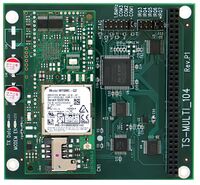TS-7250-V3 TS-MULTI-104: Difference between revisions
No edit summary |
No edit summary |
||
| Line 51: | Line 51: | ||
Type in "ATI" and press enter. This should return the cell radio name, and "OK". | Type in "ATI" and press enter. This should return the cell radio name, and "OK". | ||
For cell modems requiring the 921600 baud rate, remove the 1.8MHz jumper and in the device tree add | For cell modems requiring the 921600 baud rate, remove the 1.8MHz jumper and in the device tree add <source lang=json inline>uartclk = <14745600>;</source> after specifying the interrupts. This will allow Linux to request the baud rate 921600. | ||
The [[TS-MULTI-104#Getting_a_Data_Connection|TS-MULTI-104 manual has a second on setting up pppd]] with tmobile, but refer to your specific modem's documentation for more information on setting up a connection specific to your modem/carrier. | The [[TS-MULTI-104#Getting_a_Data_Connection|TS-MULTI-104 manual has a second on setting up pppd]] with tmobile, but refer to your specific modem's documentation for more information on setting up a connection specific to your modem/carrier. | ||
Revision as of 12:45, 5 March 2020
 | |
| Product Page | |
| 8-bit IO |
|---|
The TS-MULTI-104 supports serial based Multitech Socketmodems for cellular support.
The TS-MULTI-104 implements 16550A based UART which require a kernel driver. Under Linux this requires a device tree change. See the Kernel compile section for more details about getting set up the compile the kernel.
This below example will set up the serial devices for a TS-MULT-104 with the IRQ6, COM1, and 1.8MHz jumpers installed. Open the device tree at arch/arm/boot/dts/imx6ul-ts7250v3.dts. Add the highlighted section to the device tree and recompile.
pc104bus: fpgaisa@50 {
compatible = "technologic,pc104-bus";
reg = <0x50 0x4>;
ranges = <0 0 0x1000>;
reset-gpio = <&gpio3 7 0>;
#address-cells = <0x1>;
#size-cells = <0x1>;
status = "okay";
/* TS-MULTI-104 */
ts16550@3f8 {
compatible = "technologic,ts16550";
reg = <0x3f8 8>;
interrupt-parent = <&fpga_intc>;
interrupts = <15>;
status = "okay";
};
};
On the next boot check the "dmesg" output to verify it loaded:
root@tsimx6:~# dmesg | grep ts16550 [ 2.259413] ts16550 50004050.fpgaisa:ts16550@3f8: Adding 16550 UART ttyS0
The device node /dev/ttyS0 can be used to access this UART. As a simple test: picocom -b 115200 /dev/ttyS0
Type in "ATI" and press enter. This should return the cell radio name, and "OK".
For cell modems requiring the 921600 baud rate, remove the 1.8MHz jumper and in the device tree add uartclk = <14745600>; after specifying the interrupts. This will allow Linux to request the baud rate 921600.
The TS-MULTI-104 manual has a second on setting up pppd with tmobile, but refer to your specific modem's documentation for more information on setting up a connection specific to your modem/carrier.
The power to this modem is also under user control. By default, the modem will be powered.
# Turn off Cell modem power
pc104_peekpoke io 8 0x140 0x1
# Turn modem back on:
pc104_peekpoke io 8 0x140 0x0